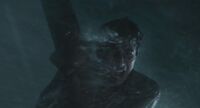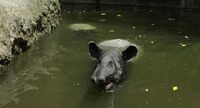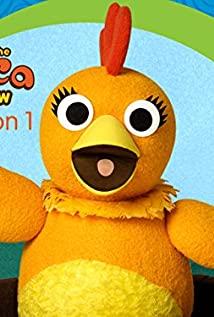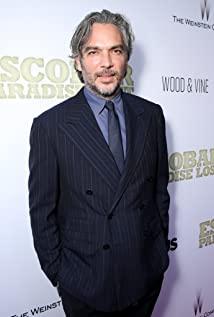Compared with the original book, the movie is much gentler in the expression of the second story: the boy never said that he ate the cook. But the film's metaphor is even more disturbing, because the island looks like a woman, which seems to imply that the teenager eventually ate his mother! There is also a more serious explanation. He has always kept his mother's corpse as an emotional attachment. He did not eat the corpse directly but maggots. -------------------------------------------------- ----------------------------------- I watched it twice within 48 hours because I couldn't let go of my doubts. The first is the baptism of vision, the second is the reading of images. The first taste is the romance of the first story. It was a fairytale-like legend told in a heartbreakingly beautiful picture. A second look at the cruelty of the second story. When the teenager begins to tell the story with a bit of ridicule, many people may not realize that this story, which is told in just one long shot, will shatter the previous story at once. But if you believe the second story, you believe another "lie". You may not understand why the investigator chose the first story? And why is this a "believe in God" story? [The heavy taste behind Xiaoqingxing] Compared with the original book, the film is much gentler in the expression of the second story: the teenager never said that he ate the cook. In fact, the cannibal island that the young man encountered on the verge of death was a metaphor for him finally starting to eat people after he lost his will due to starvation - the description of those seaweeds in the book is easily reminiscent of blood vessels ( See note); and the meerkats in the movie are like maggots crawling with corpses. But the film's metaphor is even more disturbing, because the island looks like a woman, which seems to imply that the teenager eventually ate his mother! There is also a more serious explanation. He has always kept his mother's corpse as an emotional attachment. He did not eat the corpse directly but ate maggots (Parker ate meerkat)! Judging from the few scenes that passed by in the movie, the number of days marked by the boy on the ship was only a few dozen days. According to the original text: after two weeks, the food bottomed out; after two days, the sailor was amputated, and then died and was dismembered by the cook; after that, the time unit was blurred, and the juvenile drifting was 227 days! And for that long experience, the teenager just said: "The loneliness started. I turned to God. I survived." For a person who can write pi on four blackboards, the memory should not be so chaotic. 【Who is Richard Parker? ] The tiger named "Richard Parker" has a similar origin to the boy's name: it all stems from a misunderstanding, and both are related to water (the tiger's original name is "thirsty"). It alludes to their two-in-one. In the movie, Parker doesn't seem to be seen on the ship before the shipwreck, but after the shipwreck it came. The story has strayed from the sense of reality here - because of the words of his lover Ananti, the tiger becomes the fictional listener of the teenager's self-talk. But who Parker is in the story transforms into a different identity. ●Parker=Juvenile ○ The seemingly murderous cook, but the boy's benefactor - if he hadn't dropped the lifebuoy, the boy would have been engulfed by the sea from the very beginning. But in the first story, it was the boy who dropped the lifebuoy and accidentally rescued the tiger. Here, the boy plays the role of the cook. Perhaps it was his refusal to admit that such a good deed came from a wicked man like the cook. Perhaps the young man is reflecting: If the cook did not have a single thought, there would be no subsequent killings, and he would not be killed. The boy who was rescued was a backlashing tiger. ○When the hyena killed the orangutan, the teenager was furious, and the tiger rushed out in time to kill the hyena. The tiger here is of course the externalization of the youthful revenge. It is worth noting that the tiger did not show up after getting on the boat, and the reasonable explanation is that he was hiding under the tarpaulin. As for how the hyena got on the boat, the only one of the four animals As soon as there is no explanation, the first appearance is to drill out from under the tarpaulin. How can hyenas and tigers coexist? A reasonable explanation is that the tiger is a combination of good and evil, and the hyena is the evil avatar of the tiger. ○When the tiger fell into the water and could not get on the boat, the teenager chose kindness after struggling. In the second story, the boy escapes on a raft when the cook kills his mother. If the cook could at least cut off the connecting rope to avoid future troubles, he didn't. "He kept me with a guilty conscience," the book says. At this time, the boy turned into a cook again, and the tiger turned into a boy again. In this way, the teenager relives the cook's "mental journey", which is an introspection on his own killing behavior. ○The process of killing a ghost head saury while crying seems to be a repeat of his killing the cook (one is that the cook did not resist, just like a fish throwing itself into a net; the other is that in the second story, the young man said that the cook caught a ghost at that time Knife). Afterwards, he returned to the boat to tame the tiger, which is the embodiment of the animal nature awakened by his discipline. After this, Parker became one with him. Losing his coveted opponent, the boy felt lonely. So the tiger has a lonely back under the starry sky, a sad stare, a fantasy in the deep sea, and panic and dying in the storm. ● Parker = Cook In the second story, the teenager mentioned the experience of the cook eating the mouse, so Parker, who swallowed the mouse, became the incarnation of the cook again. The humorous escape manual that appeared at the beginning of the journey was actually a story written by a teenager. There were four people on the lifeboat at that time, so he optimistically imagined the escape as a relaxing trip where he could play cards and sing together. But when he noticed the discordant atmosphere on the ship, he had to write stories to keep his consciousness awake. He imagined the vicious cook as "Parker," imagined taming it with circus tricks and enjoying spiritual triumph. Perhaps thinking in solitude, he also regards the cook as a favorable existence: because of fear, I stay alert; because I need to feed it, I have the desire to survive. ● Parker =? The tiger that went to the jungle never looked back. Is it an unbearable memory, or was it once innocent and young? After being rescued, the teenager has understood what his father called "complexity of society". He walked into the big jungle of society alone, and he has learned to protect himself. So he made up the first story, and even the second story told under questioning was a selective truth. Or maybe it was a belief that was once pure. Driven by hunger, the young man violated his belief before he had time to struggle or "say goodbye". So when he returned to the civilized world and looked at the back of Faith leaving him, "my heart was broken." 【With God】 ●A cannibalism incident in 19th century England, because Harvard Famous for impartial lessons: The three crew members who were trapped in a lifeboat survived by eating a teenager named "Richard Parker". But they were rescued and tried for murder. Their surviving flesh was cast aside by society. The novel makes "Parker" incarnate as a tiger to complete his revenge, and the purpose is to force readers to re-trial the case. The shifting of the story situation from the West to the East, the complication of character relationships (relatives, enemies, friends), and the multi-faith background of the protagonist are all perspectives that hope to enrich readers' thinking. Just imagine, if the Japanese investigators did not choose to believe the first story, would the teenager suffer the same fate? The investigator's choice is to believe in the innocence of a teenager and give hope to an orphan, which is undoubtedly a good deed with God. ●At the beginning of the movie, a lot of ink is used to describe the multiple beliefs of the teenager. But in the process of drifting, the young man cried out to God; when others chose to believe his story, he always said: So you are with God. This may be related to the Christian Eucharist: each believer eats a small piece of bread, which means eating the flesh of Jesus; and drinks a sip of wine, which means drinking the blood from the rib of Jesus, thereby "secretly united with Christ" ". Therefore, in his heart, the young man chose to use Christian teachings to interpret and forgive his compelled cannibalism. [Topic: The Struggle between Faith and Humanity] There are many dietary precepts in religious beliefs. When facing hunger, should we obey faith or obey human nature? The mother quarrelled with the cook over vegetarian food, and slapped the cook for slaughtering the sailor, but then she also ate the catch that the cook caught with the sailor's meat bait (in the original book, she even laughed with the cook because of this), which is similar to the cook who eats the sailor. What's the difference? The cook is evil, and the boy is righteous? Just like tigers and hyenas, in fact, tigers are the greatest threat to other animals. Just because hyenas are violent and tigers are behind, it seems that good and evil can be distinguished. The cook is evil, but he retains the bottom line of human beings: shame. In the face of the youth's revenge, he slaughtered his neck to complete repentance and redemption, and used his own body to save the youth. A wicked man who defied religious beliefs was finally sanctified. A teenager with multiple beliefs ends up eating people for a living. Regardless of whether you have faith or not, in the end, you will end up the same way. As the saying in the movie: more faith is actually equal to no faith. [About Memories and Future] The teenager once regarded Cannibal Island as a paradise and did not want to leave. This obviously implies that he gave up on himself because of cannibalism and did not want to return to the world until he found the teeth in the fruit. According to the teenager, the tooth belonged to the previous lost person who was swallowed by the island. The moral of the teeth is a mystery to which I cannot see an answer. (The lake on the island obviously symbolizes Looking at the stomach, did the teenager find teeth in the mother's stomach, thus awakening the pious mother to allow the compromise between faith and human nature in order to survive, thus unraveling the knot in her heart? ) The cunning of the original work is that it unabashedly expresses the echoes of the two stories in the main line, but keeps a close eye on the metaphors in the details. And when these details become figurative pictures, the metaphorical symbols are even more intertwined. A self-righteous reader and viewer is bound to over-interpret it. And the answer, like the irrational number pi, is infinite. The answer you choose, decides what kind of movie this is in your mind. Just as the memories of the teenager's choice determine the future he chooses. Think of hardship as courage and unbearable as a fairy tale, and the future will still be a legend. --------------------------------- Side note: Original Eating Seagrass Fragment: There are two concentric walls in the cross section of the seagrass : Very bright green outer wall is moist, somewhat rough, inner wall between outer wall and grass core. The demarcation between the two tubes formed by the inner and outer walls is very clear: the tube in the middle is white, and the tube that wraps around it is green, and the closer to the inner wall, the lighter the color. I put a piece of seaweed under my nose. Aside from its pleasant botanical aroma, it has an indescribable smell. I licked it. My pulse quickened. Seagrass contains fresh water. The original Eating Chef clip: His heart is hard to get - so many tubes attached. I still dug it out. It tastes good, much better than turtles. ----------------------------------- In fact, this story can have a more serious explanation: Four animals Just a family of four! Wasn't the paralyzed father the lame zebra? The hyena is the older brother. But the loophole in this explanation is that the brother's violent character is not rendered in the movie. Therefore, a more reasonable explanation is: starting from the father, the family voluntarily sacrifices itself according to the order of age. This can explain why the teenager shouted sorry for his relatives on the lifeboat. Original Eating Seagrass Fragment: The seagrass has two concentric walls in cross-section: the outer wall, which is very bright green, is moist and somewhat rough, and the inner wall is between the outer wall and the grass core. The demarcation between the two tubes formed by the inner and outer walls is very clear: the tube in the middle is white, and the tube that wraps around it is green, and the closer to the inner wall, the lighter the color. I put a piece of seaweed under my nose. Aside from its pleasant botanical aroma, it has an indescribable smell. I licked it. My pulse quickened. Seagrass contains fresh water. The original Eating Chef clip: His heart is hard to get - so many tubes attached. I still dug it out. It tastes good, much better than turtles. ----------------------------------- In fact, this story can have a more serious explanation: Four animals Just a family of four! Wasn't the paralyzed father the lame zebra? The hyena is the older brother. But the loophole in this explanation is that the brother's violent character is not rendered in the movie. Therefore, a more reasonable explanation is: starting from the father, the family voluntarily sacrifices itself according to the order of age. This can explain why the teenager shouted sorry for his relatives on the lifeboat.
View more about Life of Pi reviews











